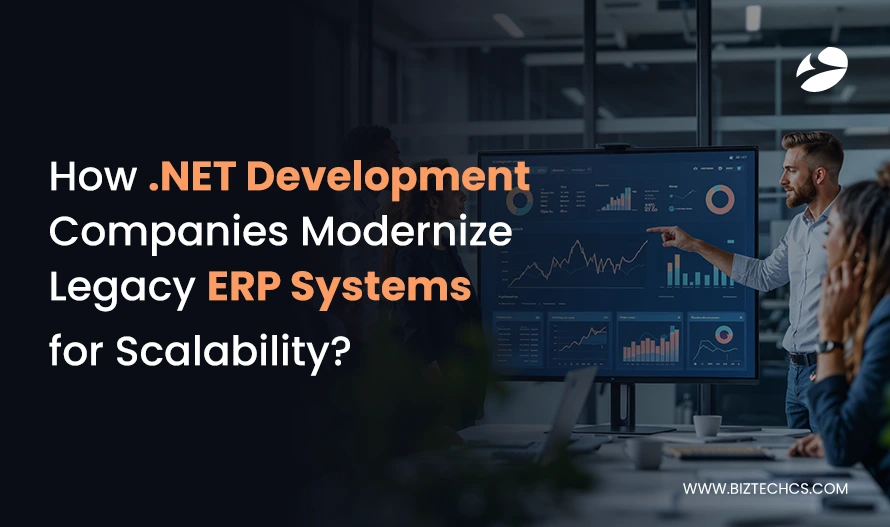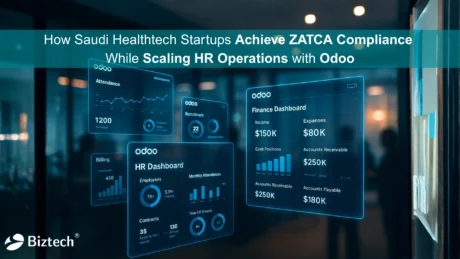1913
How .NET Development Companies Modernize Legacy ERP Systems for Scalability?
15 Jul, 2025
5 min read
1913
15 Jul, 2025
5 min read
Table of Content

Aging ERP systems have become a silent burden for many organizations. They underperform, scale poorly, and pose significant challenges when integrating with modern tools. These were unthinkable architectures back then—systems never designed to keep pace with the speed or complexity of today’s business environment.
As data volumes grow and user demands rise, the limitations of unscalable and unintegrable systems become increasingly evident, causing discomfort. In fact, over 53% of companies cite legacy systems as the biggest hurdle in digital transformation (Source: Accenture).
This is where .NET development companies bring their specialized expertise. They rebuild core components, design lightweight APIs, and restructure data flows to transform outdated platforms into scalable ERP systems that support real-time access, cloud compatibility, and future scalability. Legacy ERP modernization is not merely a code edit; it’s a complete redesign of systems to align with evolving business strategies and shifting market dynamics.
A sound plan, combined with deep technical knowledge, can turn a rigid platform into a truly agile ecosystem, without disrupting daily operations. For companies even marginally reliant on older systems, delaying is not an option. Legacy ERP modernization enables better integration, enhanced performance, and long-term sustainability. The challenge is real, but so is the opportunity.
A legacy ERP system is typically constructed on outdated, inflexible foundations. It might have functioned perfectly well when initially rolled out, but over time, the cracks began to appear.
Such systems are typically monolithic, meaning each function is strongly coupled to the next. A small alteration in one module can lead to unintended issues elsewhere. This hampers flexibility and slows down updates.
Most of these systems are not cloud-built. They’re based on legacy servers and on-premises infrastructure, making remote access challenging and scaling costly. As newer technologies—such as AI, analytics tools, and modern CRMs—emerge, integrating them can become a daunting task.
Legacy ERP systems don’t share a common language with today’s platforms, and that gap continues to widen, creating both technical and business risks.
Another concern is the user experience. Older interfaces are often slow, cluttered, and difficult to use. Training takes longer, productivity suffers, and employees prefer using external tools—leading to disconnected workflows and data silos.
These challenges make legacy ERP modernization a clear priority. It’s essential not only to stay current but also to avoid costly workarounds and rising maintenance expenses. Legacy system modernization addresses these issues by breaking down the monolithic architecture, introducing modular components, and enabling cloud deployment. This approach ensures the system is prepared for future demands without compromising the existing business logic.
Understanding these constraints is the first step toward solving them, and solving them means creating an ERP system that truly enables growth, rather than inhibiting it.
.NET development companies apply discipline and accuracy to ERP modernization. They utilize Microsoft ecosystem tools—such as .NET Core, Azure, and Power Platform—to replace inflexible, aging ERP systems with adaptable, expandable ones. The process is never rushed. It begins by disassembling large monolithic systems into smaller, stand-alone services. These are simpler to manage, test, and modify. That is the principle of modular architecture.
Then there’s API-first design. APIs enable new apps, third-party services, and even mobile platforms to communicate seamlessly. No more months-long waits to synchronize with a new CRM or BI solution. Data moves faster. Features are leveraged more effectively. And teams across departments stay connected without needing to switch systems.
Cloud scalability is a top priority. Older systems run on outdated local servers. With Azure, that burden is lifted. Developers move critical ERP components to the cloud incrementally. This minimizes downtime and reduces costs.
It also ensures the system can scale without degrading performance, even during spikes in user requests. Security is built into the process using Microsoft’s native tools, keeping business data safe.
ERP modernization using .NET is not just about fixing what’s broken—it’s about making systems leaner, more secure, and resilient to future demands. It provides the flexibility needed to adapt to changing business requirements. With careful reengineering and phased delivery, professionals mitigate risk while maintaining business continuity.
The value of ERP modernization services lies in striking the right balance—technical improvements aligned with business objectives. With solid planning and Microsoft-supported tools, .NET development companies deliver ERP modernization services that perform effectively today and adapt to tomorrow’s needs.
Re-platforming to .NET Core on Cloud Infrastructure
Legacy ERP systems are often built on outdated, rigid platforms. Re-platforming involves relocating the core system to .NET Core and running it on a cloud platform. This migration reduces infrastructure overhead and enhances system availability. It also allows updates and patches to be deployed without lengthy downtimes. The result is a more stable and economical foundation for cloud-scaled ERP solutions.
Microservices Architecture for Modular ERP Components
Breaking down a monolithic system into microservices introduces discipline and governance. Each module—such as finance, HR, or inventory—functions independently and communicates via secure Application Programming Interfaces (APIs). This approach accelerates updates and testing while minimizing the risk of a single point of failure. Microservices contribute to the agility and manageability expected in modern ERP solutions.
API Integrations with Third-Party Systems
Traditional ERP systems often lack integration with external platforms. Developers can now build API layers using .NET to enable real-time data exchange with CRMs, payment gateways, and analytics tools. This reduces data silos and eliminates manual entry, enhancing both speed and accuracy across departments. API-based design adds long-term value to scalable ERP systems.
UI/UX Modernization with Blazor or Angular Frontends
A slow, cumbersome interface can hinder user productivity and increase training costs. By utilizing Blazor or Angular, developers can modernize ERP frontends for better speed and usability. Navigation becomes more intuitive, screens load faster, and the design adapts to modern devices. These improvements drive user adoption and elevate overall efficiency, which is essential for modern ERP solutions.
Data Migration and Security Enhancements
Migrating data from legacy systems to new platforms must be executed with accuracy. The .NET toolset ensures data integrity throughout this process. Simultaneously, security measures—such as role-based access controls and encryption—are integrated to protect sensitive information. These upgrades support compliance and establish a reliable path to a secure cloud cloud-scalable ERP environment.
ERP modernization with .NET technology provides tangible and quantifiable benefits. Systems are simpler to scale as business requirements evolve. Performance is enhanced with quicker response times and more seamless data processing, even under heavy loads. Cloud deployment also enables more predictable growth and can be scaled without interruption to services. These advancements facilitate the development of scalable ERP systems that expand in lockstep with the business.
Security is another area of significant advantage. Legacy systems typically lack built-in protections. With .NET, high-level security layers can be introduced, including identity controls, encrypted sessions, and role-based security. This limits exposure to threats and supports compliance needs without additional complexity.
Maintenance expenses decrease as well. Instead of investing in hardware, patches, and support for obsolete systems, funds can be redirected toward innovation and business expansion. .NET simplifies the separation and resolution of issues, reducing the time and cost associated with managing the system. Updates can be easily rolled out over time without interrupting day-to-day operations.
User experience also improves. Contemporary frontends developed using software such as Blazor are more intuitive and easier to navigate. Staff members learn quickly, and tasks are completed with fewer clicks. Daily work becomes more efficient, and the need for training diminishes.
Together, these advancements redefine ERP as a tool that fosters, rather than hinders, growth. The move to modern ERP solutions ensures stability, security, and the capacity to expand. And with the agility of .NET technologies, modern ERP solutions can be tailored to align with long-term business objectives.
At BiztechCS, we believe that the selection of a .NET partner has a direct impact on the success of any ERP modernization project. With 18+ years of diverse experience across industries and platforms, we bring deep expertise to every project we undertake.
Our experts possess extensive knowledge of legacy system architecture and the complexities involved. Leveraging Microsoft technology, we offer end-to-end solutions tailored to each client’s unique requirements. Every project begins with a detailed roadmap, featuring clearly defined milestones and dedicated resources. We strictly adhere to timelines and maintain a diligent approach to risk management.
Our focus extends beyond technical implementation—our highest priority is the business impact of each solution. Our ERP modernization services are designed to meet immediate operational needs while staying closely aligned with long-term strategic goals.
Whether it’s a complete system overhaul or a targeted module upgrade, our solutions are comprehensively customized. As one of the leading .NET development companies, we also ensure consistent post-deployment maintenance to guarantee stability, functionality, and continuous improvement.
We understand that true progress comes from working with experts who are well-versed in both legacy challenges and modern capabilities. At BiztechCS, we value transparency, accountability, and unmatched technical excellence—empowering businesses to move forward with confidence.
If a business aims to grow or remain agile, modernizing legacy ERP systems is no longer optional. Limitations imposed by outdated platforms can hinder progress and lead to increased long-term costs. Using .NET technologies, legacy systems can be reengineered to deliver superior performance, along with effortless scalability and integration with modern tools. From modular architecture to secure cloud deployment, the value of modern design endures.
Legacy ERP modernization is, therefore, a strategic decision—one that builds systems designed to support rather than restrict business objectives. It requires the right blend of skills, planning, and tools. This is where experienced .NET development companies play a vital role. With the right partner, the transition becomes smooth, efficient, and well-managed.
BiztechCS helps businesses move forward with confidence. From planning through post-launch, every step is structured to mitigate risks and deliver value. If you’re ready to modernize, the time to act is now, and choosing the right partner makes all the difference.
All product and company names are trademarks™, registered® or copyright© trademarks of their respective holders. Use of them does not imply any affiliation with or endorsement by them.

Odoo
49
By Uttam Jain
28 Nov, 2025

Artificial Intelligence (AI)
112
By Afzal Qureshi
27 Nov, 2025

Odoo
67
By Uttam Jain
27 Nov, 2025